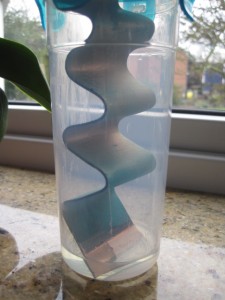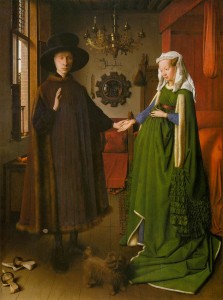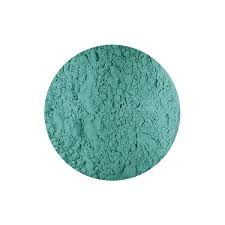Cennino Cennini, in his wonderful text Il Libro dell’Arte, describes verdigris as being ‘manufactured by alchemy, from copper and vinegar’.
So I thought I would try my own bit of kitchen windowsill alchemy.

Verdigris production – Day 2
I didn’t know quite what to expect from this little experiment, but to my astonishment the verdigris started to appear almost immediately. I’ll leave it there until there is a good layer before scraping it off and attempting to turn it into a useable pigment – that’s when the fun will start!
Cennino warned that the pigment is ‘very lovely to the eye but it does not last’. Likewise, Leonardo da Vinci said that it ‘vanishes into thin air if not varnished quickly’. Nevertheless, the Flemish artists found a way of locking the green by using a preserving varnish. The bright green skirt in Van Eyck’s The Arnolfini Marriage of 1434 is glazed with verdigris.

It was also used by Vermeer, if infrequently.
My challenge, then, is to make verdigris that stands the test of time!
Today’s bit of esoterica has to concern the use of verdigris in medicine. During the second plague pandemic amulets, or talismans, were popular. According to Joeph P. Byrne’s book on the black death, Oswald Crow, the imperial physician of Rudolf II, made amulets containing ‘inorganic mercury, sulphuric acid (vitriol), salt and verdigris cooked into a paste, died, and cut into ‘coins’. These were stamped with an alchemical ‘seal of the stars and wrapped in red silk. The silk turned blue in plaguey air, he said….
Verdigris was also used (as reported in the North American Medical and Surgical Journal, Volume 11 , 1831), boiled with honey and vinegar, to treat gangrene in the mouths of children.
Useful stuff, then.


Trackbacks/Pingbacks